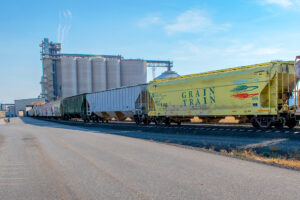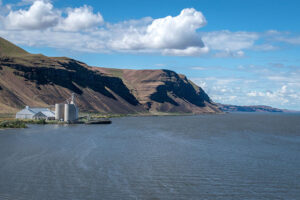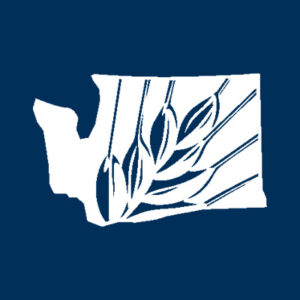Transportation infrastructure is essential for the wheat industry
Getting the food we grow to tables around the world is a fundamental element to the long-term profitability and competitiveness of Washington small grains. There are several groups working on behalf of our state’s wheat and barley farmers to keep grower concerns top-of-mind for the decision-makers of the agriculture and food production industries.
The Washington Grain Commission (WGC) works closely with the Washington Association of Wheat Growers and our national wheat organizations, the National Association of Wheat Growers (NAWG) and U.S. Wheat Associates (USW). USW is the export market development organization for the U.S. wheat industry. The WGC is also a member of the Pacific Northwest Waterways Association (PNWA), a non-profit, non-partisan trade association that advocates for federal policies and funding, and works to ensure that our waterways are efficient, reliable, and environmentally sustainable.
Part of the USW efforts to maximize the competitiveness and sustainability of U.S. wheat growers is through its Transportation Working Group. The purpose of this permanent committee is to examine and address the infrastructure factors impacting the competitiveness of U.S. wheat, both domestically and globally.
“I think it is relevant for growers to know there is a working group out there fighting for improved transportation opportunities,” said Steven Mercer, vice president for communications at USW.
At the USW/NAWG Joint Board Meeting in Cincinnati last November, the working group revised its stated goal and objective to better delineate the importance of transportation to the industry’s long-term competitiveness. To ensure this priority is appropriately reflected in USW’s efforts, the updated goal and objective were added to the USW strategic plan (see sidebar) and approved at the USW/NAWG Joint Board Meeting in Washington, D.C., in January.
Revised USW strategic goal
The U.S. transportation infrastructure will be a positive factor in USW’s reliability and value propositions.
New objective: US policy and private company decisions will not disadvantage export of wheat through the full array of transportation channels.
Action steps, USW will:
- Identify transportation constraints that limit or threaten US wheat export competitiveness.
- Work to reduce the impact of excessive rail rates on US export competitiveness.
- Actively support efforts preserving waterways as an efficient and reliable mode of transportation for US wheat.
USW Transportation Working Group Co-Chairs
- Britany Hurst Marchant, executive director, Idaho Wheat Commission
- Jim Peterson, policy and marketing director, North Dakota Wheat Commission
Washington representation
Washington growers currently serving on the USW board of directors:
- Gary Bailey, District 2 – Whitman County
- Mike Carstensen, District 1 – Spokane, Lincoln, Ferry, Stevens, Pend Oreille Counties
Recent news
Rail
 “Encompassing the largest share of inland logistics, the railroads are a critical component for moving U.S. wheat to export,” wrote USW Market Analyst Tyllor Ledford in a Wheat Letter Blog series last September. “After last year’s service disruptions, steps have been taken to help address the root issues such as hiring additional crew and investing in infrastructure. U.S. railroads are committed to moving U.S.-grown commodities.”
“Encompassing the largest share of inland logistics, the railroads are a critical component for moving U.S. wheat to export,” wrote USW Market Analyst Tyllor Ledford in a Wheat Letter Blog series last September. “After last year’s service disruptions, steps have been taken to help address the root issues such as hiring additional crew and investing in infrastructure. U.S. railroads are committed to moving U.S.-grown commodities.”
BNSF representative Brendan Camey presented an update on rail service to the USW Transportation Working Group in Cincinnati. He reported that BNSF planned a tariff reduction of $500 per car effective Jan. 1, 2024. According to Camey, the average rail rate runs about $3,700 to $43,000, and the tariff reduction would equate to about 13 cents per bushel for shipping wheat. Camey also said BNSF hoped this tariff reduction would stimulate movement. He reported that BNSF volume was down overall, including 4.3% in agriculture.
The decrease in tariff rates helps boost the competitiveness of U.S. wheat to importers, and especially helps us compete with Canada.
Barging – Mississippi River Basin
Low water conditions began in the Mississippi River Basin in September 2022. The Mississippi River is one of the busiest waterways in the U.S. Its navigable channels make up one third of all U.S. inland waterways, and 589 million tons of cargo move on the system each year. More low-water conditions throughout the basin occurred in June 2023 and the U.S. Army Corps of Engineers (USACE) worked with its local, state, and federal partners and stakeholders to mitigate the impacts. Corps dredges were engaged and responded as needs arose. The USACE Mississippi Valley Division announced on Feb. 2, 2024, the drought afflicting the Mississippi River Basin since 2022 was officially over.
“I’m happy to report there are no draft restrictions on the Mississippi River for the third week and we do not have dredges operating for low water,” said Brigadier General Kimberly Peeples, commanding general of the USACE Mississippi Valley Division.
Barging – Columbia-Snake River System
 The Columbia-Snake River System has been a topic of controversy and discussion for the last 50 years. The four dams with navigation locks and sophisticated fish passage systems managed by the USACE along the lower Snake River were once again thrown into the spotlight this past year.
The Columbia-Snake River System has been a topic of controversy and discussion for the last 50 years. The four dams with navigation locks and sophisticated fish passage systems managed by the USACE along the lower Snake River were once again thrown into the spotlight this past year.
Attention on the critical infrastructure within the Columbia-Snake River System has potentially serious implications for the essential services the lock and dam system provide for the state, region and U.S. exports, specifically for the Washington state small grains farmers who rely on Marine Highway 84 (M-84) for the environmentally friendly and fuel-efficient shipments of agricultural inputs up the river and its mass transit capacity of the high-quality food they grow down the river to export.
After a flurry of activity through January this year, with Washington wheat organizations serving as thought leaders on national media outlets and to federal policy makers, a federal judge in Oregon approved a long-term pause in Snake River litigation on Feb. 8,2024. The ruling by Judge Michael Simon means a tribal-state plan and U.S. government commitments to restore the Columbia River Basin will continue as proposed in December. The court case concerning the decline of salmon populations in the Columbia and Snake rivers in the western U.S. has been put on hold for a minimum of five years, and a $1 billion agreement for fish restoration and clean energy projects has been initiated.
“As the administration and signatories to this agreement move forward on the initial phase of their commitments, it’s vital that we stay active, question the process, and fight for our communities’ interests. We are committed to ensuring accountability from all decision-makers and will continue to bring attention to our concerns at both the regional and national levels,” PNWA Executive Director Neil Maunu said. “The producers can contribute to this by joining us in reaching out to leaders outside the Pacific Northwest whose areas would feel a direct impact if the Lower Snake River Dams are breached.”
In the meantime, scheduled maintenance on the system continues and remains on schedule. The USACE Portland District announced on Feb. 1, 2024, the closure of three navigation locks for annual inspections and maintenance. The Dalles, John Day, and Bonneville dams will close beginning on March 2 and are scheduled to reopen on March 16.
“Typically, the Portland and Walla Walla districts coordinate their annual lock closures across the Columbia-Snake River System. This year, each district is notifying the public separately due to different closure periods. Walla Walla District’s lock closure began Jan. 14 and ends Mar. 29,” the USACE Portland District announcement said. You can read the entire announcement here.
The navigation locks within the USACE Walla Walla District include the McNary Dam, located on the Columbia River, and the Lower Monumental, Little Goose, and Lower Granite dams, located on the Snake River.
“The industry prepared for the closure by proactively positioning grain and the Portland district coordinated their closure to minimize trade disruptions, which has been successful,” said Casey Chumrau, CEO of the WGC.
Ocean freight
 As of mid-February, attacks in the Red Sea are becoming less frequent, with multiple days between incidents. However, major carriers are increasingly opting to reroute around South Africa via the Cape of Good Hope. In January, the Suez Canal, which connects the northern end of the Red Sea to the Mediterranean Sea, saw a significant decrease in traffic with only 51 ships passing through compared to more than 300 in previous years.
As of mid-February, attacks in the Red Sea are becoming less frequent, with multiple days between incidents. However, major carriers are increasingly opting to reroute around South Africa via the Cape of Good Hope. In January, the Suez Canal, which connects the northern end of the Red Sea to the Mediterranean Sea, saw a significant decrease in traffic with only 51 ships passing through compared to more than 300 in previous years.
Due to longer transit times to the U.S. East Coast resulting from the Red Sea disruptions, more carriers are considering routing from the West Coast. Longer transit times around the Cape of Good Hope mean that containers are tied up for longer periods, reducing their availability for other routes and decreasing capacity by as much as 30%. This leads to increased demand on the West Coast being met with the same number of ships as before, resulting in higher costs.
In addition, the situation with low water levels at the Panama Canal is not improving and is not expected to improve in the next several months. With disruptions in both the Panama and Suez canals, demand is outstripping supply, leading to increased costs. In November 2023, 67% of shipping routes used the Suez Canal, 20% used the Panama Canal, and 13% used the Cape of Good Hope. Currently, only 9% of routes use the Suez Canal, 20% use the Panama Canal, and 71% use the Cape of Good Hope[1].
Keeping growers informed
“It is beneficial for U.S. wheat importers to be aware of transportation trends, as seasonal shifts and potential issues have a direct influence on export basis and the Free-on-Board export price,” writes Ledford.
This is also sage advice for farmers, as supply chain issues have the potential to trace all the way back to their local county elevators. With our partners on the local and national levels, the WGC continues to ensure that Washington helps U.S. wheat remain the most reliable choice for world importers.
For more information, growers with questions related to market development can contact the Washington Grain Commission office at wgc@wagrains.org or 509-456-2481.
For Washington growers who are interested in getting involved in the greater efforts to support the wheat and barley industries, the best way to get started is to attend local county grower meetings and become members of the Washington Association of Wheat Growers. For those who are interested in being more involved, consider volunteering at WAWG’s community outreach events or with the Washington Wheat Foundation. For more information on these opportunities contact KayDee Gilkey at kgilkey@wawg.org or 509-659-0610.
[1] North America Freight Market Update Live Feb 2024. Flexport, Inc. Webinar accessed 2/16/2024.

Lori Maricle, APR
Lori Maricle is the director of communication for the Washington Grain Commission.
